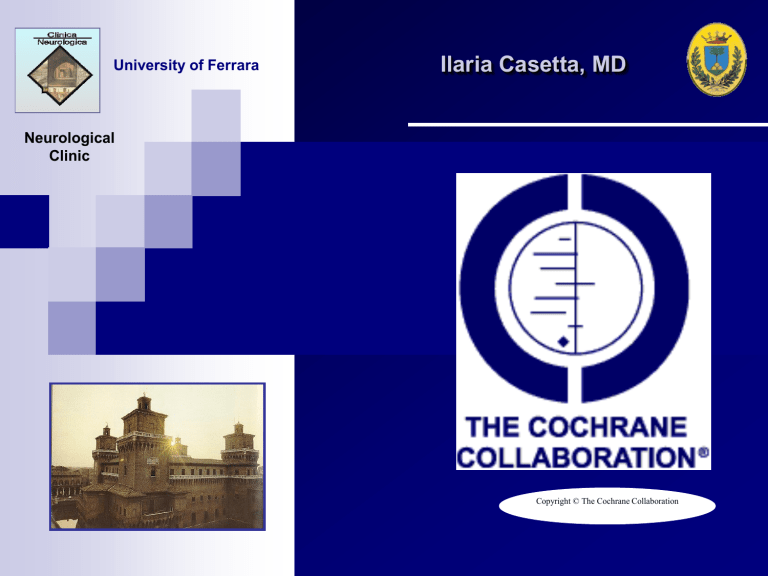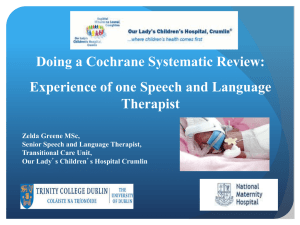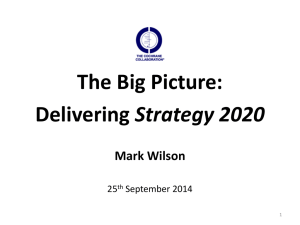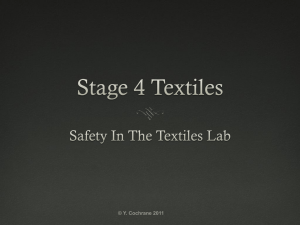Cochrane Review

Neurological
Clinic
University of Ferrara
Ilaria Casetta, MD
Copyright © The Cochrane Collaboration
BRIEF HISTORY
The Cochrane
Collaboration is named in honour of Archie
Cochrane, a British medical researcher who contributed greatly to the development of epidemiology as a science.
Professor Archibald Leman Cochrane, CBE FRCP FFCM, (1909 - 1988)
Cardiff University Library, Cochrane Archive, University Hospital Llandough.
Background
Healthcare decision-making needs to be informed by high quality, timely research evidence
Prof. Cochrane stressed the importance of using evidence from randomised controlled trials
( RCT 's) because these were likely to provide much more reliable information than other sources of evidence.
Background
"It is surely a great criticism of our profession that we have not organised a critical summary , by specialty or subspecialty, adapted periodically, of all relevant randomised controlled trials."
(1979)
Why do we need critical summaries?
Most doctors do not have the time to critically read all original papers
Often the results of available trials are not consistent
Textbooks become quickly out of date
Background and aims
Established as an international organisation in
1993, registered as a charity in the U.K.
AimTo help people make well-informed decisions about health care.
How - by preparing, disseminating and maintaining,systematic reviews of the effects of healthcare interventions across all areas of health care.
Cochrane Collaboration
More than 28,000 dedicated people from over 100 countries.
They work together to help healthcare providers, policy-makers, patients, their advocates and carers , make wellinformed decisions about health care
The members of The Cochrane
Collaboration are organised into groups, known as 'entities',
The main work of The Cochrane
Collaboration is done by more than fifty Cochrane Review
Groups
Methods Groups have been established to develop and update methodology
The work of Cochrane Groups is facilitated in various ways by the work of Cochrane Centres around the world.
The consumer network help to establish priorities and identify outcomes relevant to patient
Organization
Activity and outputs
Training courses
Methodology Handbooks
Cochrane Handbook for Systematic Reviews of Interventions
Cochrane Handbook for Diagnostic Test Accuracy Reviews
Software RevMan
Cochrane Library
www.thecochranelibrary.com
About The Cochrane Library
The Cochrane Library is a collection of six databases that contain different types of high-quality, independent evidence to inform healthcare decision-making, and a seventh database that provides information about groups in The Cochrane
Collaboration.
The Cochrane Library is a collection of evidence-based medicine databases:
The Cochrane Database of Systematic Reviews (Cochrane
Reviews)
The Cochrane Database of Abstracts of Reviews of Effects –
DARE (Other reviews)
The Cochrane Central Register of Controlled Trials- CENTRAL
(Clinical trials)
The Cochrane Methodology Register (Methods Studies)
Health Technology Assessment Database (Technology
Assessments)
NHS Economic Evaluation Database (Economic Evaluations)
About the Collaboration
Cochrane Central Register of
Controlled Trials (CENTRAL)
Includes details of published articles taken from bibliographic databases (notably MEDLINE and EMBASE), and other published and unpublished sources. CENTRAL records include the title of the article, information on where it was published (bibliographic details) and, in many cases, a summary of the article. They do not contain the full text of the article.
Each Cochrane Review Group maintains and updates a collection of controlled trials relevant to its own area of interest (handsearch)
Cochrane Methodology
Register (CMR)
is produced by the UK Cochrane Centre , on behalf of the Cochrane Methodology Review
Group .
A collection of paper that report on methods of controlled trials, and of methodological studies.
Database of Abstracts of Reviews of
Effects (DARE)
Contains abstracts of systematic reviews that have been quality-assessed. Each abstract includes a summary of the review together with a critical commentary about the overall quality.
DARE complements the CDSR by quality-assessing and summarizing reviews that have not yet been carried out by The Cochrane Collaboration ..
DARE is produced by the Centre for Reviews and
Dissemination (CRD) at the University of York, UK.
Health Technology
Assessment Database
brings together details of completed and ongoing health technology assessments (studies of the medical, social, ethical, and economic implications of healthcare interventions) from around the world. The aim of the HTA Database is to improve the quality and cost-effectiveness of health care
NHS Economic Evaluation
Database
The NHS Economic Evaluation Database
(EED) assists decision-makers by systematically identifying economic evaluations from around the world, appraising their quality, and highlighting their relative strengths and weaknesses.
Cochrane Database of
Systematic Reviews (CDSR)
Is the leading resource for systematic reviews in health care.
The CDSR includes all Cochrane Reviews
(and protocols) prepared by Cochrane
Review Groups in The Cochrane
Collaboration.
Cochrane Database of
Systematic Reviews
Each Cochrane Review is a peer-reviewed systematic review that has been prepared and supervised by a Cochrane Review
Group (editorial team) in The Cochrane
Collaboration according to the Cochrane
Handbook for Systematic Reviews of
Interventions or Cochrane Handbook for Diagnostic Test Accuracy Reviews
Cochrane Reviews
The Cochrane Reviews are prepared by authors who register titles with one of the 53 Cochrane
Review Groups (focusing on a specific topic area)
Co-ordinating Editor(s), and Editorial team including a Managing Editor and Trials Search
Co-ordinator.
The Cochrane Review Groups provide authors with methodological and editorial support to prepare Cochrane Reviews, and manage the editorial process, including peer review
Systematic review
“A review that is conducted according to clearly stated, scientific research methods, and is designed to minimize biases and errors inherent to traditional, narrative reviews.”
Margaliot, Zvi, Kevin C. Chung. Systematic Reviews: A Primer for Plastic Surgery Research. PRS
Journal. 120/7 (2007)
Systematic reviews
Systematic in identification of literature
Explicit in statement of objectives, materials, and methods
Reproducible in its methodology and conclusions
Scientific approach to a review article
Criteria determined at outset
Comprehensive search for relevant articles
Explicit methods of appraisal and synthesis
Meta-analysis may be used to combine data
Systematic process involving several steps
Formulate the question
Plan the review ( a priori protocol)
Comprehensive search
Unbiased selection and abstraction process
Critical appraisal of data
Synthesis of data (may include meta-analysis)
Interpretation of results
All steps are described explicitly in the review.
Well formulated question
P opulation (Patient,
Problem)
I ntervention
C omparison
O utcomes (primary / secondary)
EXAMPLE
Patients with MS
Beta Interferon
Placebo
Relapse rate/ disease progression
T ime After 1 year/3 years
Systematic process involving several steps
Formulate the question
Plan the review (a priori protocol)
Comprehensive search
Unbiased selection and abstraction process
Critical appraisal of data
Synthesis of data (may include meta-analysis)
Interpretation of results
All steps are described explicitly in the review.
Plan the review : protocol
The Protocol is the a priori work-plan for the eventual review. It lays out the plan in detail.
Cochrane researchers use the protocol to describe the proposed approach for a systematic review.
It outlines:
the question that the review authors are addressing (the health problem and the intervention under investigation, how benefits and harms will be measured, and the type of appropriate study design, such as the inclusion criteria of the studies).
The protocol also outlines the process for identifying, assessing, and summarizing studies in the review.
By making this information available the protocol is a public record, published in the CDSR
Systematic process involving several steps
Formulate the question
Plan the review ( a priori protocol)
Comprehensive search
Unbiased selection and abstraction process
Critical appraisal of data
Synthesis of data (may include meta-analysis)
Interpretation of results
All steps are described explicitly in the review.
Clearly stated title and objectives
Comprehensive strategy to search for relevant studies
(unpublished and published)
Explicit and justified criteria for the inclusion or exclusion of any study
Clear presentation of characteristics of each study included and an analysis of methodological quality
Comprehensive list of all studies excluded and justification for exclusion
Comprehensively search databases to find all relevant studies
PubMed
EMBASE
Cochrane Central Register of Controlled Trials (CENTRAL)
CINAHL
Web of Science
PsycINFO
LILACS
Databases from LMIC
Dissertation abstracts
Clinical trials registers
Handsearching of journals
Reference lists
Conference abstracts
Personal communication
Anything else you can think of.
Database Bias – Different database can record different studies “
Publication Bias - selective publication of articles that show positive effect of treatment and statistical significance.
English-language bias - occurs when reviewers exclude papers published in languages other than English
Citation bias - occurs when studies with significant or positive results are referenced in other publications, compared with studies with inconclusive or negative findings
Systematic process involving several steps
Formulate the question
Plan the review ( a priori protocol)
Comprehensive search
Unbiased selection and abstraction process
Critical appraisal of data
Synthesis of data (may include meta-analysis)
Interpretation of results
All steps are described explicitly in the review.
Selection process- Refine
Search
By excluding
Duplicates
Irrelevant Papers
Studies not fulfilling inclusion criteria
1814 records
Obtaining full-text of relevant studies
7 included
Abstraction process
Using a pre-define data abstraction form, authors inependently abstract the data and study characteristics from each study determined to be eligible for inclusion.
Systematic process involving several steps
Formulate the question
Plan the review ( a priori protocol)
Comprehensive search
Unbiased selection and abstraction process
Critical appraisal of data
Synthesis of data (may include meta-analysis)
Interpretation of results
All steps are described explicitly in the review.
Assessment
Risk of bias
Barry 1988 +
Baylis 1989 +
Cooper 1987 +
Dodd 1985 +
Goodwin 1986 +
Sanders 1983 +
-
+
?
?
+
+
+
+
-
+
+
-
-
?
-
+
+
-
?
+
+
+
+
?
-
?
-
-
+
-
+
-
?
?
-
?
+
-
+
?
-
+
1. Sequence generation
(randomization)
2. Allocation concealment
3. Blinding of participants, personnel and outcomes
4. Incomplete outcome data (attrition and exclusions)
5. Selective outcome reporting
6. Other (including topicspecific, designspecific)
Critical appraisal and assessment of the risk of bias for each study
Systematic process involving several steps
Formulate the question
Plan the review ( a priori protocol)
Comprehensive search
Unbiased selection and abstraction process
Critical appraisal of data
Synthesis of data (may include meta-analysis)
Interpretation of results
All steps are described explicitly in the review.
Synthesis of data
“Once the data have been extracted and their quality and validity assessed, the outcomes of individual studies within a systematic review may be pooled and presented as summary outcome or effect
When data are NOT too sparse, of too low quality or too heterogeneous
Synthesis of data when:
Studies evaluated the same outcomes
Homogeneity
Good Quality
Meta-analysis
“Meta-analysis is a statistical technique for combining the results of independent, but similar, studies to obtain an overall estimate of treatment effect.”
The validity of a metaanalysis depends on the quality of the studies included,
Meta-analysis- Forest plot
At the bottom there’s a horizontal line. This is the scale measuring the treatment effect
The vertical line in the middle is where the treatment and control have the same effect
Take care to read what the labels say – things to the left do not always mean the treatment is better than the control.
Each study is given a blob, placed where the data measure the effect.
The size of the blob is proportional to the % weight
The horizontal line is called a confidence interval and is a measure of how we think the result of this study might vary by chance.
The wider the horizontal line is, the less confident we are of the observed effect.
The pooled analysis is given a diamond shape where the widest bit in the middle is located at the calculated best guess (point estimate), and the horizontal width is the confidence interval
If the confidence interval crosses the line of no effect, we have found no statistically significant difference in the effects of the two interventions
Systematic process involving several steps
Formulate the question
Plan the review ( a priori protocol)
Comprehensive search
Unbiased selection and abstraction process
Critical appraisal of data
Synthesis of data (may include meta-analysis)
Interpretation of results
All steps are described explicitly in the review.
Interpretation of the results
What does it all mean?
Implications for patient care and future research
The Cochrane Library databases
The CDSR is published online monthly
(from 2010) with quarterly DVDs.Access is free for many people in low-income and middle-income countries via a number of initiatives. This is in addition to general access options, including national licenses and subscriptions.
Abstracts are free
The Cochrane Library usage data ,
2009
"Every day someone, somewhere searches
The Cochrane Library every second, reads an abstract every two seconds and downloads a full-text article every three seconds."
Novel methodologies
To summarize evidence across reviews
Overview of Reviews
Network Meta-Analysis



